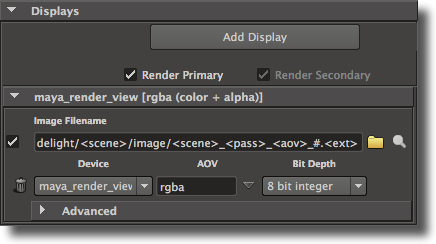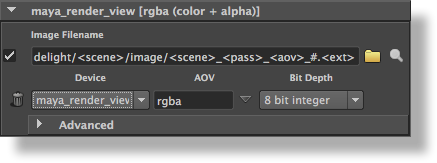Overview
Using the Displays group of attributes the user specifies one or several layers of images to output simultaneously from the rendering process. Each can be set to be displayed on screen (in a Window) or be saved to a file or both. By default, the Display group of attributes is setup to output only one image layer: the RGBA components representing the main image, also commonly referred to as the Beauty. And it is setup to be outputted to the Maya Render View.
It is possible to add any number of layers, each set to output any complementary values to the Beauty image. These are derived from variables computed inside shaders and are commonly called Arbitrary Output Variables (AOVs). Example of layers are: depth values associated to the Beauty image, original color of surfaces (without the effect of the lighting), the specular and diffuse shading components of the Beauty image. These layers can be useful for compositors to have many options while composing the final image. Refer to Display AOVs for further details on supported AOVs.
Layers can not only be generated using different AOVs, they can also be generated from different camera angles. This is very powerful for fast simultaneous multi-camera rendering (for 3D stereo for example). Additionally, each layer can contain a different subset of the objects in the scene. These are more advance options and are described in the Display Advanced Attributes.
All the layers are rendered simultaneously. Adding many layers do not generally increase rendering time significantly. This is different and not to be confused with the 3Delight for Maya functionality of Render Passes. Those are processed sequentially and can produce totally different output from one pass to another.
The Displays group
Adding, Removing and Selecting Layers
Among the user interface items inside the Displays group of attributes, there are a few buttons and a popup menu that are useful to add and remove layers and select if they are active or not. Here is a description of their functionalities:
In 3Delight for Maya, each layer of images is called Display. This is because in RenderMan, the output of the rendering is specified using RiDisplay tokens. In a future release, there will be changes and improvements to the user interface for this group of attributes and the Display labelling will be modified.
Add Display
Remove Display
Duplicate Display
To add a display, click on the Add Display button. This will add a pane for that new display. Many displays (i.e. layers) can be added this way. The Remove Display button is presented as a trashcan inside each display pane. Click on it to remove a display.
Alternately, a display can be added by right-clicking almost anywhere over the Displays group of attributes and selecting Add Display in the contextual pop-up menu. Similarly, to duplicate a display, right-click on the display to be duplicated and select Duplicate Display.
The attributes for all the displays are presented in panes below the Add Display button. Here is an example of the Display group with three displays.
Render Primary
Specifies if the primary display is to be rendered. The primary display is always the display at the top of the Displays panel and this control is tied to the first display’s Active toggle (see below). Generally, the primary display is the Beauty image simply because it is where it is first placed by default. It can be useful to turn this option off when you only need to render one or more secondary displays (such as when rendering shadow maps). By default, this toggle is on.
Render Secondary
Specifies if the other displays than the first are to be rendered. This toggle will override the per-display Active toggle (see below). This control is on by default.
Per Layer Attributes
Each pane shows basic attributes for each layer. In each pane there are also additional per-layer attributes located in the Advanced collapsable layout. Refer to the Display Advanced Attributes for a description of these advanced attributes.
Group of attributes for a specific display
Active Toggle
The check box on the left side of the text field for the Image Filename specifies if the display is active or not. If it is not active, it will not be rendered. Since the first display in the panel is considered the primary display, its Active toggle is tied to the Render Primary toggle. For other displays, their Active toggles are acknowledged only when Render Secondary is turned on.
Image Filename
Specifies the filename for saving the rendered image. By default, a filename based on the scene name and render pass name is created. See File Path Expressions for details on how it is possible to construct relative paths and paths containing dynamically expanded tokens. Next to the text field for the filename, there are two buttons (shown as icons):
| Button | Function |
|---|---|
This button brings up a file browser to specify the Image Filename. | |
| This button opens the specified Image Filename in a viewing application. Refer to The 3Delight Preferences for how to select which application should be launched. |
Device
This attribute has to distinct purposes: either to specify to view the image on screen or to specify the image format for saving the image on file. To view the image on your screen, you have two options: you select either "maya_render_view" (to view in the Maya Render View) or "idisplay" (to view in 3Delight i-Display). Alternately, to save the image on file, select between the several formats available. Refer to Image File Formats for a description of each format supported.
AOV
Specifies which AOV to generate for that display (layer). The most common values are ‘rgba’ or ‘rgb’ for the color image (the Beauty). Clicking on the arrow button next to the AOV text field pops up a menu that lists available predefined output variables. Alternately, you can write here any custom and properly defined arbitrary output variables that your shaders are using. Inline declarations of arbitrary output variables are allowed, meaning that it is permitted to preceded a variable name with its type to declare it and specify it for the display mode all at once.
The predefined AOVs (available through the menu) are explained in the Display AOVs section.
Bit Depth
Specifies how many bits to use per layer component. The available bit depth values are:
Some image formats have specific requirements as to what bit depths are supported. Refer to Image File Formats.
| Option | Description |
|---|---|
| 8 bit integer _________________ | The image will use 8 bits integer values for each component, with values ranging between 0 (black) and 255 (white). This corresponds to a quantization of 0, 255, 0, 255 for zero, one, min and max, respectively, and a dither value of 0.5. This is the default value. |
| 16 bit integer | The image will use 16 bits integer values for each component, with values ranging between 0 (black) and 65535 (white). This corresponds to a quantization of 0, 65535, 0, 65535 for zero, one, min and max, respectively, and a dither value of 0.5. |
| 16 bit float | The image will use 16 bits float values for each component. Currently, only the ‘exr’ driver supports this format. This corresponds to a quantization of 0, 0, 0, 0, and a dither value of 0 (identical to ‘32 bit float’); the display driver receives a pixel type specification through an option. |
| 32 bit float | The image will use 32 bits float values for each component. This corresponds to a quantization of 0, 0, 0, 0, and a dither value of 0. |
| Custom... | All images are rendered internally in 32-bits float format. Quantization is the process of assigning integer values to these floating-point values. Some usual preset values are available in the Bit Depth attribute. If they do not include the needed variation, it is possible to specify custom quantization values by selecting this menu entry. Upon selection, a dialog pops up, displaying the current bit depth settings. It allows specification of values for Zero, One, Min, Max and Dither amplitude. Zero is the black point, while One is the white point. These two values can be different from the Min and Max values if you need to have under-exposed or over-exposed values. An example set of values for 12 bits output with standard dithering would be: 0, 4095, 0, 4095, 0.5 An example set of values for 16 bits output with a white point at 4K that prevents over-exposed pixels from being clamped to the white value, would be: 0, 4095, 0, 65535, 0.5 |
| Other Custom entries | The option menu will also list all custom bit depths defined for all of the current image layers. |





